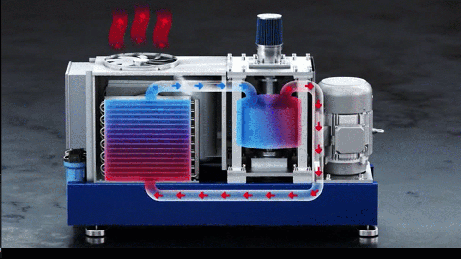The following post was written and/or published as a collaboration between Benzinga’s in-house sponsored content team and a financial partner of Benzinga.
The Carnot® Compressor compresses air with water.
This company is on a mission to revolutionize the compressor industry — doing away with oil, multiple moving parts and damage to components caused by the heat of compression. This patented process has the potential to significantly reduce energy use and total cost of ownership for compressors.
Air is compressed isothermally, and the heat is absorbed during the compression process. Rapid isothermal compression has long been thought unachievable.
The compressed air industry is ripe for new technologies. As the industry seeks to lower its carbon footprint, Carnot expects that its technology will aid the environmental transition from a carbon-heavy world to a net-zero tomorrow.
According to Carnot’s website, its technology addresses a significant global energy challenge. In the U.S., for example, industrial air compressors consume over 12% of manufacturing electricity consumption or 399 trillion BTU (British thermal units).
Carnot goes on to explain that around the globe, “compressors driven by electric motors are estimated to consume 32% of the electricity consumption from electric motor driven systems or 2,267 terawatt hours per year in 2006.”
At $0.10 per kWh, $227 billion is spent each year on compression and drains the operating expenses of businesses that use a compressor daily.
Disrupting the compressed air industry — dominated by giants like Ingersoll Rand Inc. (NYSE: IR) and Atlas Copco (OTCMKTS: ATLKY) — Carnot is working diligently to reduce these costs by more than 20% while providing an oil-free machine for the modern workshop or auto repair station. It is also designed for lower maintenance costs and longer operating life.
Oil-free Air Going In, Oil-free Air Coming Out
Air purity is of the utmost importance for numerous industries, as any small presence of oil could damage a product or an expensive piece of equipment, resulting in product loss and contamination, downtime and other setbacks.
Some speculate that oil-free, compressed air is a must-have for many facilities in manufacturing and scientific research, automotive painting and consumables, such as food and beverages. The impact the Carnot design would have on the carbon footprint would be significant in commercial, industrial and residential sectors, improving the output of everything from tire inflation to air tools, factory equipment, research gear and paint sprayers.
The Process of Compression and How the Compressor Works
The Carnot patented process delivers low temperature, oil-free, compressed air and can be operated on a 100% duty cycle. Its simple, robust design provides customers with a low-maintenance, long-operating life.
First, air is filtered into the actual compressor. It combines with water and flows into a spinning drum. As the air is compressed, the air absorbs the heat that generally causes problems during compression.
Carefully engineered, its heat exchange system maintains a consistent, low operating temperature as water circulates through the drum.
The compressor itself is environmentally friendly and has one moving part for the compression process–a spinning drum, and is designed to operate on a continuous duty cycle.
Compressed Air Markets Projected to Surpass $40 billion by 2025
The company has gained the attention and research funding of the National Science Foundation (NSF) and the California Energy Commission (CEC). Both are organizations that focus on green and cleantech technologies to eliminate the carbon footprint and decarbonize the atmosphere.
The company has filed 5 patent applications, and funding has been put to work in the validation of total system efficiencies, as well as the design, development and manufacturing of a commercial-scale prototype air compressor that has been operated in laboratory and industrial settings.
Carnot is still in the development stage and will begin beta testing in 2022. The company is raising capital on StartEngine, having raised over $620K thus far. The air compressor market is expected to reach more than $40 billion by 2025 and is expected to increase at a 3.8% compound annual growth rate (CAGR).
Current model specifications range between 15 and 30 CFM (cubic feet per minute) and 100 to 150 PSI (per square inch). The company is, however, working to significantly increase this capacity before launch.
The team behind Carnot compressors is comprised of leading experts with PhDs in engineering and includes both veterans in compressed air marketing and product development professionals.
To find out more about Carnot Compression, visit https://www.carnotcompression.com, or visit https://www.startengine.com/carnot-compression to invest.
The preceding post was written and/or published as a collaboration between Benzinga’s in-house sponsored content team and a financial partner of Benzinga. Although the piece is not and should not be construed as editorial content, the sponsored content team works to ensure that any and all information contained within is true and accurate to the best of their knowledge and research. This content is for informational purposes only and not intended to be investing advice.




